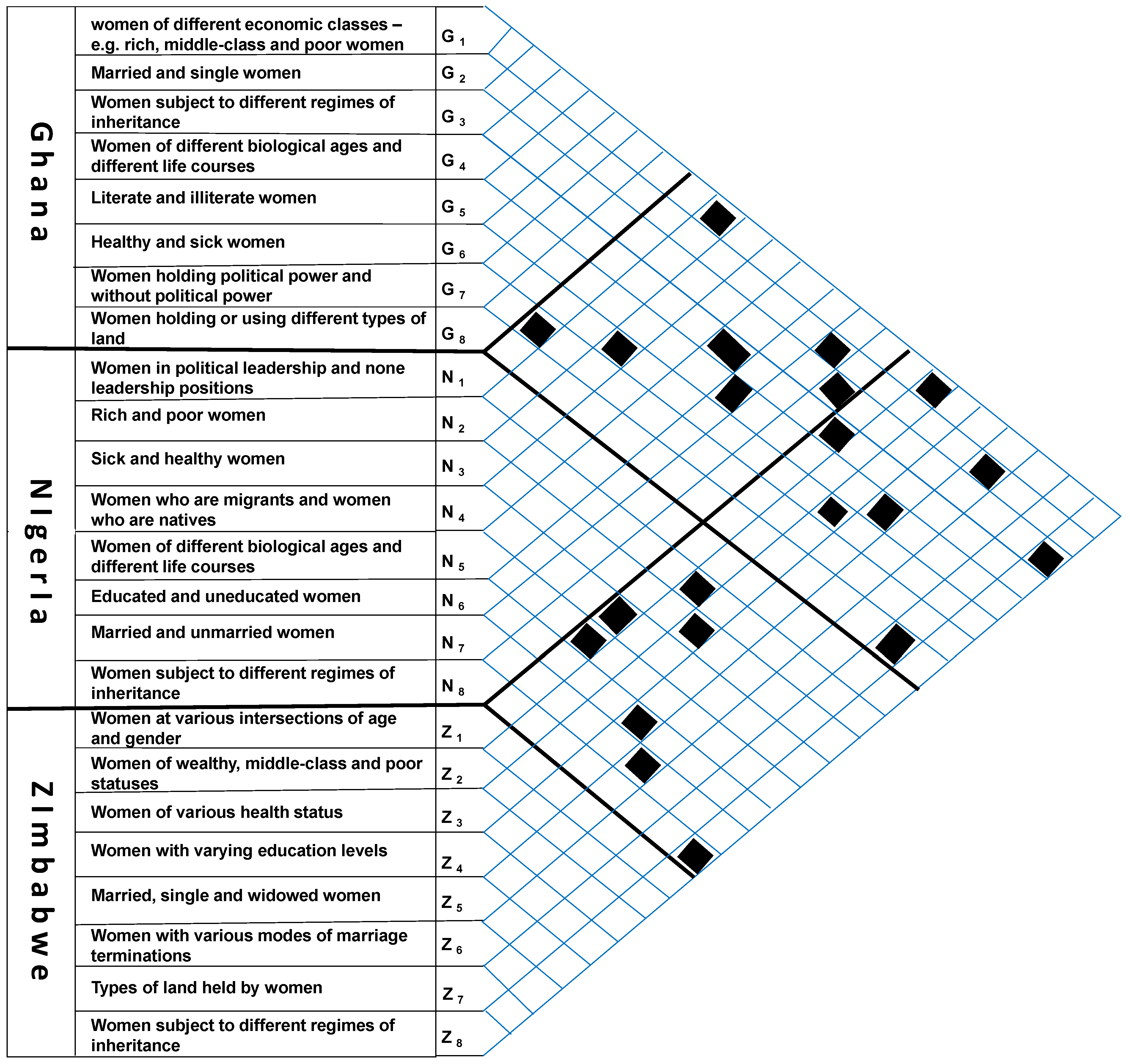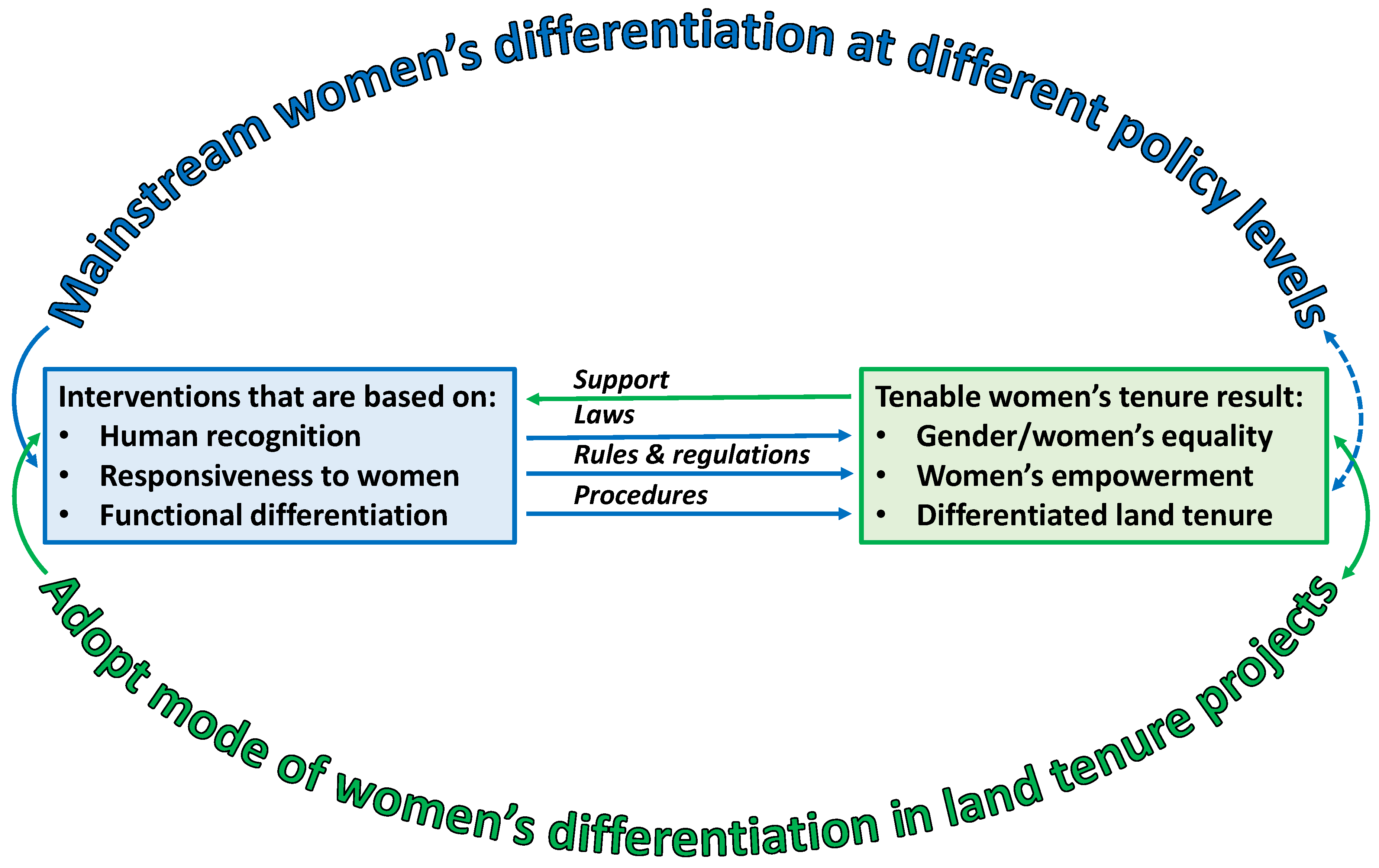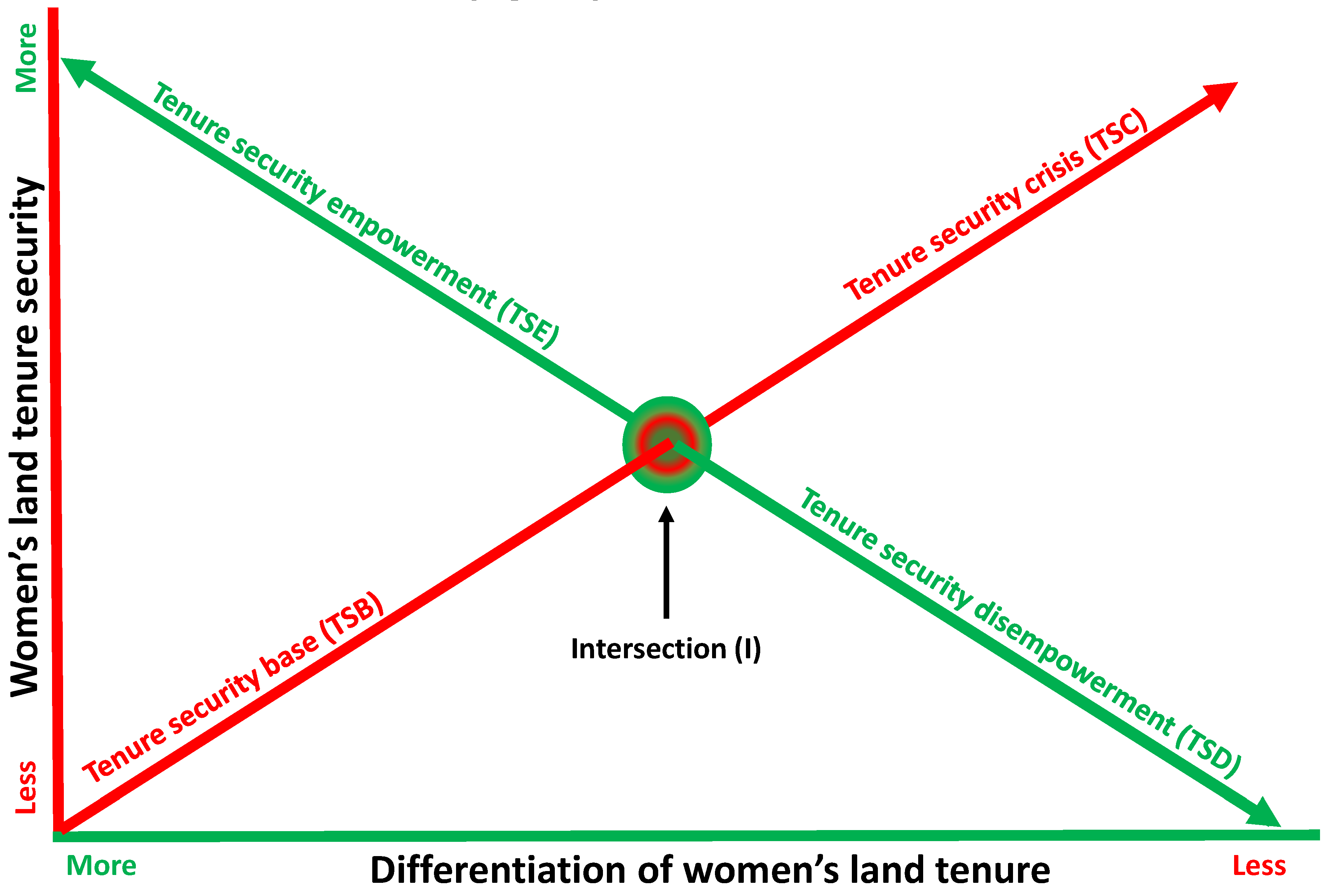Differentiations in Women’s Land Tenure Experiences: Implications for Women’s Land Access and Tenure Security in Sub-Saharan Africa
Abstract
1. Introduction
2. Materials and Methods
3. Theorising Women’s Land Tenure Issues by Systematically Recognising Women from Homogenisation to Differentiation
3.1. Homogenising Women Is Tantamount to a Lack of Human Recognition
3.2. Functional Differentiation Theory as a Path to Women’s Empowerment
4. Results: From Theory to Reality—Women’s Differentiation in Ghana, Nigeria, and Zimbabwe
4.1. Differentiated (Yet Interlinked) Matrix of Scenarios of Women’s Land Tenure
4.2. Categories of Sources of Women’s Differentiation
- Economic status: Economic position of women in relation to others.
- Marital status: Women’s state of being married (polygamy or monogamy) separated, widowed, single, or divorced.
- Type of land: Category of land based on the purpose for which women use it.
- Health status: Women’s state of wellness and/or burden of care.
- Education status: Women’s level of attainment of formal education.
- Life cycle stage: Age and stage in life cycle.
- Inheritance regime: The status women assume at birth or are assigned later in life (voluntarily or involuntarily) in the succession of land—for example, patriarchal versus matriarchal systems (big gap between practise and theory).
- Spatial location or habitation of women: Women’s residence in urban, peri-urban, or rural areas or locations.
- Socio-political status: Relationship to powerful individuals.
- Migrant status: Women who are non-natives versus those who are natives of the place from which they hold land rights.
4.3. How Differentiation Informs Land Tenure in Nigeria, Ghana, and Zimbabwe
4.3.1. Economic Status of Women
4.3.2. Type of Land Used or Owned by Women
4.3.3. Health Status and/or Burden of Care of Women
4.3.4. Marital Status of Women
4.3.5. Education Status of Women
4.3.6. Life Cycle Stage of Women
4.3.7. Inheritance Regime in Which Women Live
4.3.8. Women’s Settlement Area (e.g., Urban, Rural, or Peri-Urban)
4.3.9. Migrant Status of Women
4.3.10. Women’s Relationship (to Those) with Power
5. Discussion and Policy Emerging Issues
5.1. Towards Embracing Women’s Differentiation in Land Tenure Issues
5.2. Adopting Modes of Action in Support of Women’s Differentiation
- Tenure security base (TSB): The tenure security base for women is generally accepted to be low in SSA for reasons pertaining to cultural practices inherent in customary tenure [65]. This means that, ceteris paribus, the starting point for women in terms of tenure security is generally low.
- Tenure security crisis (TSC): As women generally start from a low base of tenure security, the less differentiation is applied in handling their tenure security alleviation, the greater chance there will be a crisis in the future. A tenure security crisis for women is a situation in which enhancement of tenure security alludes majority of the women who are poor (due to homogenization of women).
- Tenure security disempowerment (TSD): Women become more disempowered (in terms of tenure security) as their land tenure experiences become less differentiated (or continue to be undifferentiated).
- Tenure security empowerment (TSE): Women become less disempowered (or more empowered in terms of tenure security) as their tenure security experiences become more differentiated.
- Intersection (I): This is the equilibrium point. It occurs when women’s differentiation leads to tenure security. At this point, recognising women’s differentiation in policy implementation produces tenure security and different kinds of women can be reached via policy implementation on land tenure.
5.3. Mainstreaming Women’s Differentiation at Land Policy or Project Levels
6. Conclusions
Author Contributions
Conflicts of Interest
Informed Consent
References
- Chigbu, U.E.; Izugbara, C.O.; de Vries, W.T. Land, Culture, Culture Loss and Community: Rural Insights from Sub-Saharan Africa. In The Routledge Handbook of Community Development: Perspectives from around the Globe; Kenny, S., McGrath, B., Phillips, R., Eds.; Routledge: London, UK, 2018; pp. 98–114. [Google Scholar] [CrossRef]
- Ribot, C.; Peluso, N.A. Theory of Access. Rural Sociol. 2003, 68, 153–181. [Google Scholar] [CrossRef]
- UN-Habitat. Secure Land Rights for All; UN-Habitat: Nairobi, Kenya, 2008; Available online: https://unhabitat.org/books/secure-land-rights-for-all/ (accessed on 8 November 2018).
- Tutu, D.O.; Asante, L.A.; Appiah, M.N.; Bendzko, T.; Chigbu, U.E. Towards a Pro-Poor Customary Land Rights Security in Rural Ghana: Land Tenure Inventory Using Mobile Application by Local Youth. In Proceedings of the World Bank Land and Poverty Conference, Washington, DC, USA, 14–18 March 2016; Available online: https://www.researchgate.net/publication/298787264_Towards_a_pro-poor_customary_land_rights_security_in_rural_Ghana_land_tenure_inventory_using_mobile_application_by_local_youth (accessed on 8 November 2018).
- Chigbu, U.E.; Schopf, A.; de Vries, W.T.; Masum, F.; Mabikke, S.; Antonio, D.; Espinoza, J. Combining land-use planning and tenure security: A tenure responsive land-use planning approach for developing countries. J. Environ. Plan. Manag. 2017, 60, 1622–1639. [Google Scholar] [CrossRef]
- Orcherton, D.; Mitchell, D.; McEvoy, D. Perceptions of climate vulnerability, tenure security and resettlement priorities: Insights from Lami Town, Fiji Islands. Aust. Geogr. 2016, 48, 235–254. [Google Scholar] [CrossRef]
- FAO. Gender and Access to Land; FAO: Rome, Italy, 2002; ISBN 92-5-104847-9. [Google Scholar]
- Paradza, G. Differentiation of Women’s Land Tenure Security in Southern Africa. PLAAS and International Land Coalition Working Paper. March 2011. Available online: http://www.landcoalition.org/en/resources/differentiation-women-s-land-tenure-security-southern-africa (accessed on 12 November 2018).
- Makura-Paradza, G. Single Women, Land and Livelihood Vulnerability; Wageningen Publishers: Wageningen, The Netherlands, 2010. [Google Scholar] [CrossRef]
- Chigbu, U.E. Masculinity, men and patriarchal issues aside: How do women’s actions impede women’s access to land? Matters arising from a peri-rural community in Nigeria. Land Use Policy 2019, 81, 39–48. [Google Scholar] [CrossRef]
- Ekejiuba, F. Down to the Fundamentals: Women Centred Hearth-Holds in Rural West Africa. In Women Wielding the Hoe: Lessons from Rural Africa for Feminist Theory and Development Practice; Bryceson, D., Ed.; Berg: London, UK, 1995; pp. 47–61. Available online: https://www.bloomsbury.com/au/women-wielding-the-hoe-9781859730737/ (accessed on 12 November 2018).
- Paradza, G. Single Women’s experiences of livelihood conditions, HIV and AIDs in the rural areas of Zimbabwe. In AIDS and Rural Livelihoods. Dynamics and Diversity in Sub-Saharan Africa; Niehof, A., Rugalema, G., Gillespie, S., Eds.; Earthscan: London, UK, 2010; pp. 77–95. ISBN 978-90-8585-474-6. [Google Scholar]
- Bouilly, E.; Rillon, O.; Cross, H. African women’s struggles in a gender perspective. Rev. Afr. Political Econ. 2016, 43, 338–349. [Google Scholar] [CrossRef]
- Moyo, S. A Gendered Perspective of the Land Question. S. Afr. Fem. Rev. 1995, 1, 13. Available online: https://search.proquest.com/openview/15e65e6ead841c344685bf65b7c2794f/1?pq-origsite=gscholar&cbl=44162 (accessed on 1 December 2018).
- Chigbu, U.E. Rurality as a choice: Towards ruralising rural areas in sub-Saharan African countries. Dev. S. Afr. 2013, 30, 812–825. [Google Scholar] [CrossRef]
- Chigbu, U.E. Repositioning culture for development: Women and development in a Nigerian rural community. Community Work Fam. 2015, 18, 334–350. [Google Scholar] [CrossRef]
- Mohanty, C. Feminism without Borders: Decolonizing Theory, Practicing Solidarity; Duke University Press: Durham, NC, USA, 2003; Available online: https://www.dukeupress.edu/feminism-without-borders (accessed on 1 December 2018).
- Radcliffe, A.S. Post-Colonial Women: Authority, Difference and Feminisms. Area 1994, 26, 25–32. Available online: https://www.jstor.org/stable/20003369 (accessed on 22 November 2018).
- Smeeta, M. ‘Liberation’ vs. ‘Purity’: Representations of Saudi Women in the American Press and American Women in the Saudi Press. Howard J. Commun. 2007, 18, 259–276. [Google Scholar] [CrossRef]
- Narayan, U. Essence of Culture and a Sense of History: A Feminist Critique of Cultural Essentialism. Hypatia 2009, 13, 86–106. Available online: https://www.jstor.org/stable/3810639 (accessed on 24 November 2018). [CrossRef]
- Wilson, K. ‘Race’, gender and neoliberalism: Changing visual representations in development. Third World Q. 2011, 32, 315–331. [Google Scholar] [CrossRef]
- Hansson, J.; Henriksson, M. Western NGOs Representation of “Third World women”—A Comparative Study of Kvinna till Kvinna (Sweden) and Women for Women International (USA). Bachelor’s Thesis, University West, Trollhättan, Sweden, 2013. Available online: http://www.diva-portal.org/smash/get/diva2:632032/fulltext01.pdf (accessed on 25 November 2018).
- Rocheleau, D.; Edmunds, D. Women, men and trees: Gender, power and property in forest and agrarian landscapes. World Dev. 1997, 25, 1351–1371. [Google Scholar] [CrossRef]
- Gray, L.; Kevane, M. Diminished access, diverted exclusion: Women and land tenure in sub-Saharan Africa. Afr. Stud. Rev. 1999, 42, 15–39. Available online: https://scholarcommons.scu.edu/econ/27/ (accessed on 29 November 2018). [CrossRef]
- Flintan, F. Sitting at the table: Securing benefits for pastoral women from land tenure reform in Ethiopia. J. East. Afr. Stud. 2010, 4, 153–178. [Google Scholar] [CrossRef]
- Holden, S.T.; Otsuka, K. The roles of land tenure reforms and land markets in the context of population growth and land use intensification in Africa. Food Policy 2014, 48, 88–97. [Google Scholar] [CrossRef]
- Greiner, C. Pastoralism and Land-Tenure Change in Kenya: The Failure of Customary Institutions. Dev. Chang. 2017, 48, 78–97. [Google Scholar] [CrossRef]
- Luhmann, N. Differentiation of Society. Can. J. Sociol. 1977, 2, 29–53. Available online: https://www.jstor.org/stable/3340510 (accessed on 27 November 2018). [CrossRef]
- Luhmann, N. The Differentiation of Society; Columbia University Press: New York, NY, USA, 1982; ISBN 13 9780231049962. [Google Scholar]
- Luhmann, N. Ecological Communication; Polity Press: Cambridge, UK, 1989; ISBN 10 0745605001. [Google Scholar]
- Luhmann, N. Essays on Self-Reference; Columbia University Press: New York, NY, USA, 1990; ISBN 10 0231063687. [Google Scholar]
- Luhmann, N. Social Systems; Stanford University Press: Stanford, CA, USA, 1995; ISBN 0-8047-2625-6. [Google Scholar]
- Luhmann, N. The world society as a social system. Int. J. Gen. Syst. 1982, 8, 131–138. [Google Scholar] [CrossRef]
- Luhmann, N. The autopoiesis of social systems. In Sociocybernetic Paradoxes; Geyer, F., van der Zouwen, J., Eds.; Sage: London, UK, 1986; pp. 172–192. ISBN 0-8039-9735-3. [Google Scholar]
- Luhmann, N. Political Theory in the Welfare State; Walter de Gruyter: Berlin, Germany; New York, NY, USA, 1990; ISBN 13 9780899255545. [Google Scholar]
- Luhmann, N. Globalization or World Society: How to Conceive of Modern Society? Int. Rev. Sociol. 1997, 7, 67. [Google Scholar] [CrossRef]
- Luhmann, N. Observations on Modernity; Stanford University Press: Stanford, CA, USA, 1998; ISBN 13 9780804732352. [Google Scholar]
- Mattheis, C. The System Theory of Niklas Luhmann and the Constitutionalization of the World Society. Goettingen J. Int. Law 2012, 4, 625–647. [Google Scholar] [CrossRef]
- Luhmann, N. Theories of Distinction: Redescribing the Descriptions of Modernity; Stanford University Press: Stanford, CA, USA, 2002; ISBN 13 9780804741231. [Google Scholar]
- Luhmann, N. Are there still indispensable norms in our society? Soz. Syst. 2008, 14, 18–37. [Google Scholar] [CrossRef]
- Ziemann, B. The Theory of Functional Differentiation and the History of Modern Society. Reflections on the Reception of Systems Theory in Recent Historiography. Soz. Syst. 2007, 13, 220–229. [Google Scholar] [CrossRef]
- Brans, M.; Rossbach, S. The Autopoiesis of Administrative Systems: Niklas Luhmann on Public Administration and Public Policy. Public Adm. 1997, 75, 417–419. [Google Scholar] [CrossRef]
- Heidegren, C. Recognition and Social Theory. Acta Sociol. 2004, 47, 365–373. [Google Scholar] [CrossRef]
- Castleman, T. Human Recognition and Economic Development: An Introduction and Theoretical Model. In Oxford Poverty & Human Development Initiative (OPHI) Working Paper; No. 63; Department of International Development, University of Oxford: Oxford, UK, 2013; Available online: https://www.ophi.org.uk/wp-content/uploads/ophi-wp-63.pdf (accessed on 2 December 2018).
- Kabeer, N. Inclusive Citizenship: Meanings and Expressions; Zed Books: Chicago, IL, USA, 2005; ISBN 13 978-1842775493. [Google Scholar]
- Kabeer, N. Resources, Agency, Achievements: Reflections on the Measurement of Women’s Empowerment. Dev. Clim. Chang. 1999, 30, 435–464. [Google Scholar] [CrossRef]
- Castleman, T. Measurement of Human Recognition: A Methodology with Empirical Applications in India and Kenya; George Washington University: Washington, DC, USA, 2013. [Google Scholar] [CrossRef]
- Schweiger, G.; Graf, G. The Subjective Experience of Poverty. SATS 2014, 15, 148–167. [Google Scholar] [CrossRef]
- Makarovic, M. Some Problems in Luhmann’s Social Systems Theory: Differentiation, Integration, and Planning. Druæboslovne Razprave 2001, 42, 59–70. Available online: http://dk.fdv.uni-lj.si/dr/dr37-38makarovic.PDF (accessed on 2 December 2018).
- Kim, J. The social and the political in Luhmann. Contemp. Political Theory 2015, 14, 355–376. [Google Scholar] [CrossRef]
- Triandis, H.C. Individualism and Collectivism; Routledge: New York, NY, USA, 2018; ISBN 0-8133-1849-1. [Google Scholar]
- Giddens, A. The Constitution of Society. Outline of the Theory of Structuration; Polity Press: Cambridge, UK, 1984; Available online: http://www.communicationcache.com/uploads/1/0/8/8/10887248/the_constitution_of_society.pdf (accessed on 5 December 2018).
- Hull, D. Science as a Process: An Evolutionary Account of the Social and Conceptual Development of Science; University of Chicago Press: Chicago, IL, USA, 1988; ISBN 9780226360515. [Google Scholar]
- Hannan, M.T.; Pólos, L.; Carroll, G.R. The Organizational Niche. Sociol. Theory 2003, 21, 309–340. Available online: https://www.jstor.org/stable/1602329 (accessed on 4 December 2018). [CrossRef]
- Wortmann, H. A Simple Evolutionary Model of Social Differentiation. Zeitschrift Für Soziologie 2012, 41, 75–391. [Google Scholar] [CrossRef]
- Abbott, A. The System of Professions: An Essay on the Division of Expert Labor; University of Chicago Press: Chicago, IL, USA, 2014; ISBN 10 0226000699. [Google Scholar]
- Festré, A.; Garrouste, P. Wieser as a theorist of institutional change. J. Hist. Econ. Thought 2016, 38, 463–483. [Google Scholar] [CrossRef]
- Autant-Mathieu, M.C. “I am not a theorist, I am an inspirer”: How Nemirovich-Danchenko interpreted the Stanislavski system. Stanisl. Stud. 2017, 5, 123–131. [Google Scholar] [CrossRef]
- Hagen, R. Rational Solidarity and Functional Differentiation. Acta Sociol. 2000, 43, 27–43. Available online: https://www.jstor.org/stable/4201180 (accessed on 3 December 2018). [CrossRef]
- USAID. Land Tenure and Women’s Empowerment. USAID Factsheet. 1 December 2016. Available online: https://www.land-links.org/issue-brief/fact-sheet-land-tenure-womens-empowerment/ (accessed on 30 November 2018).
- Cousins, B.; Winer, D.; Amin, N. Social Differentiation in the Communal Lands of Zimbabwe. Rev. Afr. Political Econ. 1992, 19, 5–24. [Google Scholar] [CrossRef]
- Chant, S. Women-Headed Households: Diversity and Dynamics in the Developing World; Palgrave Macmillan: Hampshire, UK, 1997. [Google Scholar]
- Van Der Westhuizen, C. Afrikaners in post-apartheid South Africa: Inward migration and enclave nationalism. HTS Theol. Stud. 2016, 72, 1–9. [Google Scholar] [CrossRef]
- Meister, A.; Sinclair, A.; Jehn, K.A. Identities under scrutiny: How women leaders navigate feeling misidentified at work. Leadersh. Q. 2017, 28, 672–690. [Google Scholar] [CrossRef]
- Alden, W.L. The Community Land Act in Kenya Opportunities and Challenges for Communities. Land 2018, 7, 12. [Google Scholar] [CrossRef]
- Federal Government of Nigeria. Land Use Act; Federal Republic of Nigeria: Abuja, Nigeria, 1990. Available online: http://www.nigeria-law.org/Land%20Use%20Act.htm (accessed on 29 November 2018).
- Federal Government of Nigeria. National Gender Policy; Federal Republic of Nigeria: Abuja, Nigeria, 2006. Available online: http://www.aacoalition.org/national_policy_women.htm (accessed on 30 November 2018).
- Federal Government of Nigeria. National Gender Policy Strategic Framework (Implementation Plan) Federal Republic of Nigeria 2008–2013; Federal Republic of Nigeria: Abuja, Nigeria, 2008.
- Government of Ghana. Draft Land Bill. National Land Policy; Government of Ghana: Accra, Ghana, 2016.
- Government of Ghana. National Land Policy; Government of Ghana: Accra, Ghana, 1999.
- Mushunje, M.T. Women’s Land Rights in Zimbabwe; Broadening Access and Strengthening Input Market Systems (BASIS): Madison, WI, USA, 2001. [Google Scholar]
- Government of Zimbabwe. Draft National Land Policy; Government of Zimbabwe: Harare, Zimbabwe, 1999.
- AUC-ECA-AfDB Consortium. Framework and Guidelines on Land Policy in Africa: Land Policy in Africa—A Framework to Strengthen Land Rights, Enhance Productivity and Secure Livelihoods; ECA Publications: Addis Ababa, Ethiopia, 2010; Available online: https://www.uneca.org/sites/default/files/PublicationFiles/fg_on_land_policy_eng.pdf (accessed on 19 November 2018).
- Bryceson, D.F. Ganyu casual labour, famine and HIV/AIDS in rural Malawi: Causality and casualty. J. Mod. Afr. Stud. 2006, 44, 173–202. [Google Scholar] [CrossRef]
- Borras, S.M.; Franco, J.C. Contemporary Discourses and Contestations around Pro-Poor Land Policies and Land Governance. J. Agrar. Chang. 2010, 10, 1–32. [Google Scholar] [CrossRef]
- Sunderland, T.; Achdiawan, R.; Angelsen, A.; Babigumira, R.; Ickowitz, A.; Paumgarten, F.; Reyes-García, V.; Shively, G. Challenging perceptions about men, women, and forest product use: A global comparative study. World Dev. 2014, 64, S56–S66. [Google Scholar] [CrossRef]
- Deininger, K.; Xia, F.; Holden, S.T. Gender-Differentiated Impacts of Tenure Insecurity on Agricultural Performance in Malawi’s Customary Tenure Systems. World Bank Policy Research Working Paper 2017, No. 7943. Available online: http://documents.worldbank.org/curated/en/266351484763758405/Gender-differentiated-impacts-of-tenure-insecurity-on-agricultural-performance-in-Malawis-customary-tenure-systems (accessed on 6 December 2018).



© 2019 by the authors. Licensee MDPI, Basel, Switzerland. This article is an open access article distributed under the terms and conditions of the Creative Commons Attribution (CC BY) license (http://creativecommons.org/licenses/by/4.0/).
Share and Cite
Chigbu, U.E.; Paradza, G.; Dachaga, W. Differentiations in Women’s Land Tenure Experiences: Implications for Women’s Land Access and Tenure Security in Sub-Saharan Africa. Land 2019, 8, 22. https://doi.org/10.3390/land8020022
Chigbu UE, Paradza G, Dachaga W. Differentiations in Women’s Land Tenure Experiences: Implications for Women’s Land Access and Tenure Security in Sub-Saharan Africa. Land. 2019; 8(2):22. https://doi.org/10.3390/land8020022
Chicago/Turabian StyleChigbu, Uchendu Eugene, Gaynor Paradza, and Walter Dachaga. 2019. "Differentiations in Women’s Land Tenure Experiences: Implications for Women’s Land Access and Tenure Security in Sub-Saharan Africa" Land 8, no. 2: 22. https://doi.org/10.3390/land8020022
APA StyleChigbu, U. E., Paradza, G., & Dachaga, W. (2019). Differentiations in Women’s Land Tenure Experiences: Implications for Women’s Land Access and Tenure Security in Sub-Saharan Africa. Land, 8(2), 22. https://doi.org/10.3390/land8020022






